Prairie Seedlings
Tuesday, June 2nd was an exciting day. We walked to our 3,000 square foot patch of dirt that, until recently had been a lawn, and spotted bits of feathery green poking through the dirt. They were baby partridge peas, scattered somewhat evenly through the patch.
Last winter we decided to extend our long-term effort of transforming mowed lawn into the native prairie. In our first blogs, called Prairie Renaissance, we shared why we are doing this, early planning, and ground preparation, and seeding. You can view these on windingpathways.com. This blog tells how we manage our newly planted prairies and some of the tools we use.
Tools for Prairie Management*
*Most tools we bought ourselves. The EGO trimmer we received for testing
By far the most important “tool” for establishing a prairie is Patience. Seed a conventional lawn in the spring and it’s well established that same year. Roll out the sod and the lawn is immediate. Not so with the prairie. It needs time.
When we planted one of our first prairies in the 1980s at the Indian Creek Nature Center Jock Ingels was our mentor. His words ring true. Here’s what he said after advising us to scatter prairie seed on existing bromegrass”Plant those seeds and early next spring burn the grass. Then look carefully. You won’t see any prairie plants and think you wasted your time. Don’t give up. Burn off the grass that autumn or the next spring and watch again. You might see just a few prairie plants that year but still think you’ve wasted your time. But by the third year, the miracle starts. You’ll see more prairie plants, and it will keep getting better and better each year after.”
He was right. Planting a prairie on the existing brome is an exercise in patience. We did it because we had no money for herbicides or ground preparation. For our new prairie at Winding Pathways, we wanted to speed up the process by killing the existing lawn and baring the soil. It’s a “fast” way to start a prairie, but that’s relative. It still takes patience.
Partridge pea is a prairie sprinter. It’s an annual that shows up the first year with its pretty legume yellow bloom. Ours will bloom this summer and, if all goes well, we’ll also have Coreopsis and Black-Eyed Susans soon welcoming bees and butterflies. Newly planted prairies usually bloom with yellow flowers the first few years, while blue and red-toned flowers take longer to establish. So, we expect “yellow” in 2020 and gradually more color and species diversity as the years progress.
Planting a prairie is a little more like planting a tree than a vegetable or conventional flower garden. Patience helps.
Hands-on Tools to Help Manage Our Prairies
- Hand and battery-powered clippers to remove fast-growing weeds.
- We bought a self-propelled power lawnmower – EGO Mower. It’s quiet, effective, and inexpensive to operate.
- A battery-powered string trimmer. This allows cutting weeds higher than most lawnmowers.
- Plant identification books, especially those that have photos of seedlings and butterflies. Many books and websites help identify both prairie plants and weeds as well as insects and spiders. We recently have begun using an app called SEEK, produced by the National Geographic Society and the World Wildlife Fund. It’s free. You snap a photo of the plant, bird, insect, or fungus you want to identify and, presto, most of the time it immediately tells what it is. Many books and online resources help identify mature and blooming plants but seedlings are challenging. An outstanding guide for identifying prairie seedlings is PRAIRIE SEEDLING AND SEEDING EVALUATION GUIDE, which is available by PDF by simply Googling the publication’s name.
-
- We use a variety of tools to manage the emerging prairie.
- By early June a blush of green carpeted the upslope.
- Partridge pea is an easy prairie plant to identify.
First Year Prairie Management
Transforming a lawn to a prairie doesn’t eliminate maintenance but it does reduce it. In its first year, a prairie needs special attention. Broadcast prairie seeds on bare ground and soon weeds march right in. In their establishment state prairie plants prioritize root growth over leaves. A rank growth of weeds can snuff them out. Young prairie plants are difficult to identify but generally hug the ground while weeds reach for the sky.
So, for the first two years, we will mow our prairie at the highest height our mower can be set at. This buzzes off the interloping weeds and lets the shorter prairie have sunlight. We’ll mow it three or four times the first year, one or two the second, and then quit mowing altogether once the prairie is established. Sometimes we use our battery-powered string trimmer to cut weeds higher than our lawnmower allows or in places where the ground is rough and the mower doesn’t work well. Future maintenance will involve burning and occasionally clipping out weeds.
Fertilizer and Water
Weeds love fertilizer. Prairie plants don’t need it. There is an irony. Over thousands of years dying prairie plants, especially their roots, created the wonderful topsoil of today’s Corn Belt, yet they do well in poor soil. We never fertilize our prairies. They just don’t need it, and if we did sprinkle some on our plantings the weeds would appreciate it and grow even faster.
The same for water. Prairies are drought tolerant. Their roots penetrate upwards of 15 feet down, drawing water from the subsoil. Watering a prairie mostly helps shallow-rooted weeds. We also completely avoid pesticides and herbicides, with the exception of killing the sod before our initial planting.
A perfect lawn needs infusions of water, fertilizer, and chemicals that stimulate so much growth that frequent mowing is needed. In contrast, a prairie doesn’t need them and, once established, needs little to no mowing.
An Excellent Resource
The Monarch Research Project is doing amazingly good work encouraging people to plant native species that make our world more beautiful and boost populations of beneficial wildlife, especially monarch butterflies. Their website is a host of information and has outstanding webinars on why and how landowners can make our earth a healthier place.
- Black-Eyed Susans are biennials.
- Monarch
- By summer we may see Coreopsis.
Our Next Prairie Renaissance blog will be in late summer when we’ll showcase both emerging prairie plants and some of the weeds that bedevil prairies. Later in the fall, a blog will detail prairie prescribed burning.

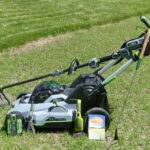
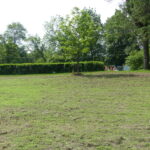
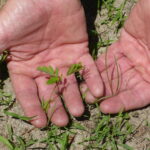
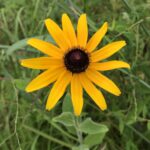
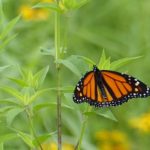
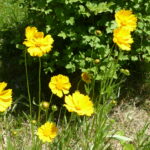

This is an exciting adventure. I can hardly wait to see how the prairie evolves.
Jac
We will keep readers updated.
I’m reading awesome book by Jennifer Ackerman: GENIUS OF BIRDS
It’s so interesting that I’ll buy my own copy and return this one to the library!
Thanks, Dianne! I’ll see about finding a copy. M~